Related Research Articles
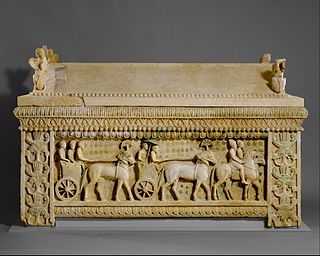
Amathus or Amathous was an ancient city and one of the ancient royal cities of Cyprus until about 300 BC. Some of its remains can be seen today on the southern coast in front of Agios Tychonas, about 24 miles (39 km) west of Larnaca and 6 miles (9.7 km) east of Limassol. Its ancient cult sanctuary of Aphrodite was the second most important in Cyprus, her homeland, after Paphos.

The League of Corinth, also referred to as the Hellenic League, was a confederation of Greek states created by Philip II in 338–337 BC. The League was created in order to unify Greek military forces under Macedonian leadership (hegemony) in their combined conquest of the Persian Achaemenid Empire.

The Battle of Himera, supposedly fought on the same day as the Battle of Salamis, or at the same time as the Battle of Thermopylae, saw the Greek forces of Gelon, King of Syracuse, and Theron, tyrant of Agrigentum, defeat the Carthaginian force of Hamilcar the Magonid, ending a Carthaginian bid to restore the deposed tyrant of Himera. The alleged coincidence of this battle with the naval battle of Salamis and the resultant derailing of a Punic-Persian conspiracy aimed at destroying the Greek civilization is rejected by modern scholars. Scholars also agree that the battle led to the crippling of Carthage's power in Sicily for many decades. It was one of the most important battles of the Sicilian Wars.
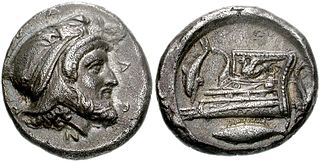
The Battle of Cnidus was a military operation conducted in 394 BC by the Achaemenid Empire against the Spartan naval fleet during the Corinthian War. A fleet under the joint command of Pharnabazus and former Athenian admiral, Conon, destroyed the Spartan fleet led by the inexperienced Peisander, ending Sparta's brief bid for naval supremacy.
Evagoras or Euagoras was the king of Salamis in Cyprus, known especially from the work of Isocrates, who presents him as a model ruler.

The naval Battle of Salamis in 306 BC took place off Salamis, Cyprus between the fleets of Ptolemy I of Egypt and Antigonus I Monophthalmus, two of the Diadochi, the generals who, after the death of Alexander the Great, fought each other for control of his empire.

The ancient history of Cyprus shows a precocious sophistication in the Neolithic era visible in settlements such as at Choirokoitia dating from the 9th millennium BC, and at Kalavassos from about 7500 BC.
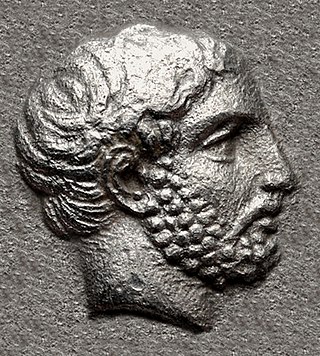
Hecatomnus of Mylasa or Hekatomnos was an early 4th-century BC ruler of Caria. He was the satrap (governor) of Caria for the Persian Achaemenid king Artaxerxes II. However, the basis for Hecatomnus' political power was twofold: he was both a high appointed Persian official and a powerful local dynast, who founded the hereditary dynasty of the Hecatomnids. The Hecatomnids followed the earlier autochthonous dynasty of the Lygdamids in Caria.

Idrieus, or Hidrieus was a ruler of Caria as a Satrap under the Achaemenid Empire. Alongside his sister and wife Ada, he enjoyed the status of king or dynast by virtue of the powerful position he inherited from his predecessors of the House of Hecatomnus.
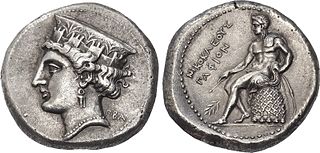
Nicocles was a king of Paphos on the island of Cyprus. As king, Nicocles changed the capital of Paphos, from the old one to the new one. In 321 BC, he allied himself with Ptolemy I to fight against Perdiccas and Antigonus.
Nicocles was an Ancient Cyprian Greek king of Salamis, Cyprus. In 374/3 BC, he succeeded his (presumed) father Evagoras I. Nicocles continued the philhellenic politics of his father. Nicocles probably died together with Straton of Sidon during the revolt of satraps. He was followed as the Cypriot king of Salamis by his son Evagoras II.
The Second Athenian League was a maritime confederation of Aegean city-states from 378 to 355 BC and headed by Athens, primarily for self-defense against the growth of Sparta and secondly, the Persian Empire.

Near the site of the first battle and great Carthaginian defeat of 480 BC, the Second Battle of Himera was fought near the city of Himera in Sicily in 409 between the Carthaginian forces under Hannibal Mago and the Ionian Greeks of Himera aided by an army and a fleet from Syracuse. Hannibal, acting under the instructions of the Carthaginian senate, had previously sacked and destroyed the city of Selinus after the Battle of Selinus in 409. Hannibal then destroyed Himera which was never rebuilt.
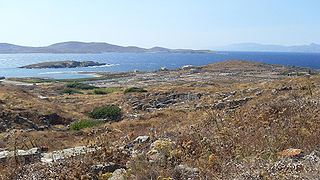
The Wars of the Delian League were a series of campaigns fought between the Delian League of Athens and her allies, and the Achaemenid Empire of Persia. These conflicts represent a continuation of the Greco-Persian Wars, after the Ionian Revolt and the first and second Persian invasions of Greece.
The siege of Segesta took place either in the summer of 398 BC or the spring of 397 BC. Dionysius the Elder, tyrant of Syracuse, after securing peace with Carthage in 405 BC, had steadily increased his military power and tightened his grip on Syracuse. He had fortified Syracuse against sieges and had created a large army of mercenaries and a large fleet, in addition to employing catapults and quinqueremes for the first time in history. In 398 BC he attacked and sacked the Phoenician city of Motya despite a Carthaginian relief effort led by Himilco II of Carthage. While Motya was under siege, Dionysius besieged and assaulted Segesta unsuccessfully. Following the sack of Motya, Segesta again came under siege by Greek forces, but the Elymian forces based in Segesta managed to inflict damage on the Greek camp in a daring night assault. When Himilco of Carthage arrived in Sicily with the Carthaginian army in the spring of 397 BC, Dionysius withdrew to Syracuse. The failure of Dionysius to secure a base in western Sicily meant the main events of the Second Sicilian war would be acted out mostly in eastern Sicily, sparing the Elymian and Phoenician cities the ravages of war until 368 BC.
The sack of Camarina in Sicily took place during the Sicilian Wars in 405 BC.

Orontes I was a Bactrian nobleman, who served as a military officer of the Achaemenid Empire in the first half of the 4th-century BC. He first appears in 401 BC as the satrap of the satrapy of Armenia. There he participated in the Battle of Cunaxa, where he harassed the Ten Thousand following their retreat. In the same year, he married Rhodogune, a daughter of the King of Kings Artaxerxes II.
Evagoras or Euagoras may refer to:

Evagoras II or Euagoras II was a king of the Ancient Greek city-state of Salamis in Cyprus, and later satrap for Achaemenid Persia in Phoenicia.
Pnytagoras was a king of the Ancient Greek city-state of Salamis in Cyprus. He was the nephew and successor of Evagoras II, who was overthrown in 351 BC and exiled due to his pro-Achaemenid stance.
References
- Abdemon. In: Neuer Pauly (English: Brill's New Pauly), vol. 1, 1996, col. 11-12.
